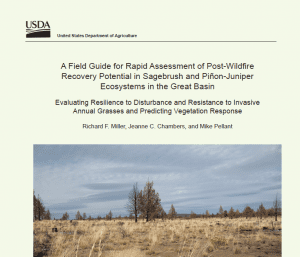Post-fire Environment & Management
View report.
This report examines federal officials’ and stakeholders’ views on (1) factors that affect federal-nonfederal collaboration aimed at reducing wildland fire risk to communities and (2) actions that could improve their ability to reduce risk to communities.
View report.
In this study, new parameterization schemes for erodibility were developed for the application of RHEM on undisturbed and disturbed rangelands. In most cases, only one erodibility parameter (KSS) is needed to run the model, minimizing the error that can be generated from the parameterization process.
View bulletin.
This bulletin summarizes recent research on biological soil crusts, which are a complex of microscopic organisms growing on the soil surface in many arid and semi-arid ecosystems. These crusts perform the important role of stabilizing soil and reducing or eliminating water and wind erosion. One of the largest threats to biological soil crusts in the arid and semi-arid areas of the western United States is mechanical disturbance from vehicle traffic and grazing. The spread of the annual invasive cheatgrass has increased the fuel load in areas that previously would not carry a fire, posing a potentially widespread and new threat to this resource.
View article.
This study found that prescribed fires conducted under favorable conditions (2011) induced potentially positive bighorn responses including high survival and increased use of treated areas. Fires during drought conditions were more widespread with little vegetative response (2012) and coincided with increased bighorn mortality in spring 2013.
View article.
In this study, researchers concluded that variability in tree regeneration after disturbance can dampen and delay future disturbance by breaking spatiotemporal synchrony on the landscape. This highlights the importance of fostering landscape variability in the context of ecosystem management given changing disturbance regimes.
View article.
In this study, field sampling and analysis were conducted across environmental gradients following the 2007 Tongue-Crutcher Wildfire in southwestern Idaho to determine the conditions most influential in post-fire vegetation recovery patterns. Duff depth and fire severity were determined to be the most influential factors affecting post-fire vegetation response.
View article.
This study explored recovery of Wyoming big sagebrush (Artemisia tridentata ssp.wyomingensis) and basin big sagebrush (A. tridentata ssp. tridentata) communities following fire in the northern Columbia Basin (Washington, USA). Density of large–mature big sagebrush plants and percentage cover of big sagebrush were higher with time since fire and in plots with more precipitation during the winter immediately following fire, but were lower when precipitation the next winter was higher than average, especially on soils with higher available water supply, and with greater post-fire mortality of mature big sagebrush plants. Bunchgrass cover 5 to 28 years after fire was predicted to be lower with higher cover of both shrubs and non-native herbaceous species, and only slightly higher with time. Post-fire recovery of big sagebrush in the northern Columbia Basin is a slow process that may require several decades on average, but faster recovery rates may occur under specific site and climate conditions.
View abstracts.
These abstracts of recent papers on rangeland management in the West were prepared by Charlie Clements, Rangeland Scientist, USDA Agricultural Research Service, Reno, NV.
View article.
This study evaluated the effects of fire on biological soil crusts of early-seral juniper. Compared with unburned plots, the biomass of cyanobacteria was diminished under juniper and sagebrush; it was reduced in the interspaces in both burned and unburned plots, presumably in response to generally harsher conditions in the postburn environment. Nitrogen fixation rates declined over time in juniper plots and interspaces but not in sagebrush plots. Although fire negatively affected some biological soil crust organisms in some parts of the early-seral juniper woodland, the overall impact on the crusts was minimal. If the intent of burning is to reduce juniper, burning of early-seral juniper woodland is appropriate, as most affected trees were killed. Burning early-seral juniper may be preferred for controlling juniper encroachment on rangeland.
View field guide.
This field guide provides a framework for rapidly evaluating post-fire resilience to disturbance, or recovery potential, and resistance to invasive annual grasses, and for determining the need and suitability of the burned area for seeding. The framework identifies six primary components that largely determine resilience to disturbance, resistance to invasive grasses, and potential successional pathways following wildfire, as well as the information sources and tools needed to evaluate each component.
The components are: (1) characteristics of the ecological site; (2) vegetation composition and structure prior to the wildfire; (3) fire severity; (4) post-wildfire weather; (5) post-wildfire management, especially grazing; and (6) monitoring and adaptive management.
The tools provided are: (1) a conceptual model of the key components that largely determine resilience to disturbance and resistance to invasive annual grasses of the burn area, (2) a guide to evaluate post-wildfire severity, (3) indicators to estimate pre-wildfire plant composition and structure if not known, and (4) an evaluation score sheet to rate an area’s potential post-wildfire resilience to disturbance, resistance to invasive annual grasses and, thus, the need for seeding and probability of success.


